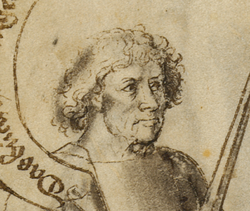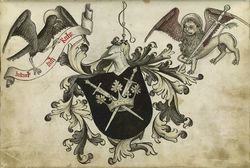|
|
You are not currently logged in. Are you accessing the unsecure (http) portal? Click here to switch to the secure portal. |
Hans Talhoffer
|
|
The Universitätsbibliothek Augsburg has rejiggered their online image gallery system, and all links to their manuscript scans are currently broken. While we address this problem, you can navigate to the scans through this portal: Universitätsbibliothek Augsburg Digitale Sammlungen. |
| Hans Talhoffer | |
|---|---|
 | |
| Born | ca. 1410-15 Swabia |
| Died | after 1482 |
| Occupation |
|
| Patron |
|
| Movement | Marxbrüder (?) |
| Genres | |
| Language | Early New High German |
| Archetype(s) |
MS Thott 290.2º (1459)
|
| Manuscript(s) |
Codex I.6.2º.1 (before 1561)
|
| First printed english edition |
Rector, 2000 |
| Concordance by | Michael Chidester |
| Translations | |
| Signature |  |
Hans Talhoffer (Dalhover, Talhouer, Thalhoffer, Talhofer) was a 15th century German fencing master. His martial lineage is unknown, but his writings make it clear that he had some connection to the tradition of Johannes Liechtenauer, the grand master of the German school of fencing. Talhoffer was a well educated man, who took interest in astrology, mathematics, onomastics, and the auctoritas and the ratio. He authored at least five fencing manuals during the course of his career, and appears to have made his living teaching, including training people for trial by combat.
The first historical reference to Talhoffer is in 1433, when he represented Johann II von Reisberg, archbishop of Salzburg, before the Vehmic court. Shortly thereafter in 1434, Talhoffer was arrested and questioned by order of Wilhelm von Villach (a footman to Albrecht III von Wittelsbach, duke of Bavaria) in connection to the trial of a Nuremberg aristocrat named Jacob Auer, accused of murdering of his brother. Auer's trial was quite controversial and proved a major source of contention and regional strife for the subsequent two years. Talhoffer himself remained in the service of the archbishop for at least a few more years, and in 1437 is mentioned as serving as a bursary officer (Kastner) in Hohenburg.[1]
The 1440s saw the launch of Talhoffer's career as a professional fencing master. His first manuscript, the MS Chart.A.558, was a personal reference book created in ca. 1443. The fencing manual portion is largely text-less and it may have been designed as a visual aid for use in teaching; in addition to these illustrations, it also contains an astrological treatise and a copy of Konrad Kyeser's famous war book Bellifortis. Most notable among the noble clients that Talhoffer served in this period was the Königsegg family of southern Germany, and some time between 1446 and 1459[2] he produced the MS XIX.17-3 for this family. This work depicts a judicial duel being fought by Luithold von Königsegg and the training that Talhoffer gave him in preparation, but it seems that this duel never actually took place.[3]
Talhoffer's name appears again in the records of the city of Zürich in 1454, where he was chartered to teach fencing in some capacity and to adjudicate judicial duels. The account notes that a fight broke out among his students and had to be settled in front of the city council, resulting in various fines.[4] He seems to have passed through Emerkingen later in the 1450s, where he was contracted to train the brothers David and Buppellin vom Stain; he also produced the MS 78.A.15 for them, a significantly expanded version of the Königsegg manuscript.[5]
In 1459,[6] Talhoffer commissioned the MS Thott.290.2º, a new personal fencing manual along the same lines as his 1443 work but expanded with additional content and captioned throughout. He appears to have continued instructing throughout the 1460s, and in 1467 he produced his final manuscript, Codex Icon 394a, for another of his noble clients, Eberhardt I von Württemberg.[7] This would be his most extensive work, and the graf paid 10 Guilder as well as quantities of rye and oats for the finished work.[8]
While only a few facts are known about Talhoffer's life, this has not stopped authors from conjecture. The presence of the Lion of St. Mark in Talhoffer's 1459 coat of arms (right) has given rise to speculation that he may have been an early member or even a founder of the Frankfurt-am-Main-based Marxbrüder fencing guild, though there is no record of their existence prior to 1474.[citation needed] Additionally, much has been made of the fact that Talhoffer's name doesn't appear in Paulus Kal's list of members of the Society of Liechtenauer.[9] While some have speculated that this indicates rivalry or ill-will between the two contemporaries, Kal's list seems to be a memorial to masters who were already deceased,[10] so it is more likely that Talhoffer was simply still alive in ca. 1470 (just three years after writing his final book).
Treatises
Main article: Hans Talhoffer/Personal
|
Main article: Hans Talhoffer/Königsegg
|
Main article: Talhoffer Fechtbuch (MS Thott.290.2º)
|
Main article: Hans Talhoffer/Württemberg
|
For further information, including transcription and translation notes, see the discussion page.
Additional Resources
- Zwei junge Männer kämpfen mit Schwertern und ringen miteinander, von einem älteren Mann beaufsichtigt. 1826 - 1850.
- Hergsell, Gustav, and Talhoffer, Hans. Livre d'escrime de Talhoffer (codex Gotha) de l'an 1443. Prague: Chez L'Auteur, 1893.
- Hergsell, Gustav, and Talhoffer, Hans. Livre d'escrime de Talhoffer (manuscrit d'Ambras) de l'an 1459. Prague: Chez L'Auteur, 1890.
- Hergsell, Gustav, and Talhoffer, Hans. Livre d'escrime de Talhoffer de l'an 1467. Prague: Chez L'Auteur, 1894.
- Hergsell, Gustav, and Talhoffer, Hans. Talhoffers Fechtbuch (Ambraser Codex) aus dem Jahre 1459: gerichtliche und andere Zweikämpfe darstellend. Prague: J.G. Calve, 1889.
- Hergsell, Gustav, and Talhoffer, Hans. Talhoffers Fechtbuch (Gothaer Codex) aus dem Jahre 1443: gerichtliche und andere Zweikämpfe darstellend. Prague: Selbstverlag, 1889.
- Hergsell, Gustav, and Talhoffer, Hans. Talhoffers Fechtbuch aus dem jahre 1467: Gerichtliche und andere zweikämpfe darstellend. Prague: J.G. Calve, 1887.
- Hull, Jeffrey, with Maziarz, Monika and Żabiński, Grzegorz. Knightly Dueling: The Fighting Arts of German Chivalry. Boulder, CO: Paladin Press, 2007. ISBN 1-58160-674-4
- Knight, Hugh T., Jr. The Ambraser Codex by Master Hans Talhoffer. Lulu.com, 2009. ISBN 978-0-557-38531-7
- Rector, Mark, and Talhoffer, Hans. Medieval Combat: A Fifteenth-Century Illustrated Manual of Swordfighting and Close-Quarter Combat. Greenhill Books, 2000. ISBN 978-1853674181
- Schulze, André and S.E. Johannes Graf zu Königsegg-Aulendorf. Der Königsegger Codex. Die Fechthandschrift des Hauses Königsegg. Geschichte Neu Erleben: Philipp von Zabern, 2010. ISBN 978-3-8053-3753-3
References
- ↑ Hans Talhoffer. "Hans Talhoffer’s life". Hans Talhoffer ~ The fencing and life of Hans Talhoffer. Retrieved 17 March 2012.
- ↑ Hans-Peter Hils. Meister Johann Liechtenauers Kunst des langen Schwertes. Peter Lang, 1985. p73.
- ↑ Hans Talhoffer. "Who was Luithold of Königsegg?". Hans Talhoffer ~ The fencing and life of Hans Talhoffer. Retrieved 17 March 2012.
- ↑ Hans-Peter Hils. Meister Johann Liechtenauers Kunst des langen Schwertes. Peter Lang, 1985. p176.
- ↑ Hans-Peter Hils. Meister Johann Liechtenauers Kunst des langen Schwertes. Peter Lang, 1985. p42.
- ↑ Internally dated on folio 103v.
- ↑ Internally dated and dedicated on folio 16v.
- ↑ Hans Talhoffer. "1467 The price of a fencing master". Hans Talhoffer ~ The fencing and life of Hans Talhoffer. Retrieved 17 March 2012.
- ↑ Paulus Kal. Untitled [manuscript]. Cgm 1507. Munich, Germany: Bayerische Staatsbibliothek, ca. 1470.
- ↑ It includes the traditional blessing on the dead.
- French Translation
- Hungarian Translation
- Slovenian Translation
- Spanish Translation
- Public Domain
- PD-permission
- Copyrighted
- GNU GPLv3
- Masters
- Translation
- German
- Archery
- Arming Sword
- Armored Fencing
- Dagger
- Flail
- Grappling
- Longshield
- Longsword
- Marriage Counseling
- Messer
- Mounted Fencing
- Pole Weapons
- Staff Weapons
- Sword and Buckler


